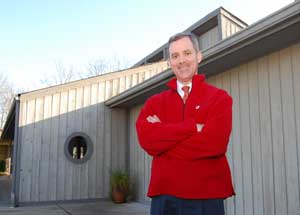Editorial
Front Page - Friday, December 18, 2009
St. Nicholas uses innovative approach to educate students
David Laprad

Located on 24 scenic acres in East Brainerd, St. Nicholas has many things in common with other grade schools. It’s made up of buildings, hallways and classrooms, for starters. During school hours, teachers and students occupy those rooms, engaged in a timeless exchange. And because there’s a beginning and an end to each day, there are schedules to keep and assignments to complete.
To casual observers, it might look like just another school, albeit one with a sterling academic reputation. However, St. Nicholas is missing a few things found in most other elementary schools — like neat rows of desks and children who’d rather be anywhere else.
Since its establishment in 1957 as a preschool program at Grace Episcopal Church, St. Nicholas has followed its own path, one that places more responsibility on the student than schools that use traditional teaching methods.
“We have different ideas about how kids learn,” says Mark Fallo, head of school. “Our teachers don’t stand at the front of the room dispensing information. And our students don’t do certain things because they’re in first grade and then do certain things because they’re in second grade.
“That’s too much like the assembly line model that became prevalent in the ’50s. Our kids play an active role in their learning, and our teachers guide them through the process.”
The idea is to meet children where they are, as kids learn differently and progress at different rates, Fallo says. One student might be on page 75 of a math book, for example, while another is on page 52. The child that’s struggling, however, doesn’t have to move on because the rest of the class is ready for the next lesson; rather, he can continue working on page 52 until he’s nailed the concept.
In addition, lessons at St. Nicholas are tailored to encourage each student to explore his natural curiosities and strong points. Although classes are small, it’s not uncommon for a teacher to create a different spelling list for each of his students or assign each child a different book to read.
This approach is more labor intensive, as instructors oftenhave to draw up multiple lesson plans for a single group of students, but the results are worth the effort, Fallo says.
To succeed under this model, students must learn to manage their time well. Fortunately for them — and their parents — the school’s teachers take a firm hand in this area.
“Starting in first grade, our students get a plan sheet for the week. As they get older, the sheet gets more sophisticated, so by the time they’re in fifth grade, there are quite a few things listed under homework and class work.”
Once the sheet is in a student’s hands, he’s responsible for getting the work done. When he completes an assignment, rather than tugging on his teacher, he can move on to one of the classroom station activities on his sheet.
“We give them opportunities to make decisions,” Fallo says. “It’s better to learn that at a young age than in high school, when kids face more difficult decisions socially and academically.”
Another important part of the learning process at St. Nicholas is mistakes, says Fallo. Rather than slapping a student’s hand with a stiff ruler, teachers encourage kids to value their mistakes and learn from them. This allows students to take risks and try different things, Fallo says.
Teachers at St. Nicholas do use group instruction for certain subjects, such as social studies, but even in those cases, the school colors outside the lines by weaving common threads through multiple classes. As a result, a student might learn words in Spanish class that are related to what he’s doing in science.
While the St. Nicholas approach sounds good on paper, does it work? Two years ago, the valedictorian and salutatorian at Baylor School were former students from the school. Going further back, John Meacham, editor of Newsweek, and Jordan Thomas, founder of the Jordan Thomas Foundation, are graduates of St. Nicholas.
The final part of the puzzle at St. Nicholas is the school’s Episcopal identity. Each day begins with chapel, Fallo says, but since students of many different faiths attend the school, the lessons generally focus on how they should treat one another and how they can be the person God wants them to be. “We want each child to grow in his or her faith, whatever that might be,” Fallo says.
While St. Nicholas might not be trying to churn out little Episcopalians, with its focus on the intellectual and spiritual growth of its students, and its innovative approach to fostering that growth, the school should be producing future John Meachams and Jordan Thomases for years to come.
Learn more at www.stns.org.
|
|